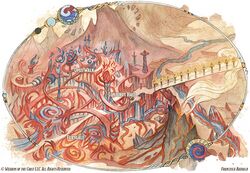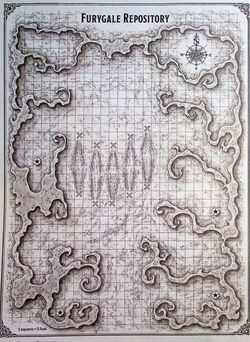Furygale
| Furygale | |
|---|---|
| Information | |
| Plane | Arcavios |
| Colors |
|
| Part of | Prismari Campus, Strixhaven, Orrithia |

Furygale is a volatile region located within the Prismari campus at Strixhaven University, widely known for its unrestrained elemental activity and chaotic magical phenomena. Officially designated as the Furygale Repository, the area serves as a containment zone for centuries' worth of discarded artistic experiments and abandoned magical constructs.
Description
Furygale encompasses several square blocks of terrain perpetually reshaped by the uncontrolled mingling of elemental forces. Over the years, failed performances, rogue elementals, and magical constructs cast aside by generations of artist-mages have accumulated within the zone, forming a dangerous yet mesmerizing landscape. Gales of fire, wind, and ice regularly sweep through the area, and spells left to decay over decades sometimes unravel with explosive consequences.
Despite its dangers, Furygale exerts a strong allure. Its erratic nature is seen by many as a raw expression of magical creativity, and it remains a favored dueling ground for students seeking seclusion from campus authorities. Access is restricted and monitored, with the zone roped off by magical wards and floating warning signs that read "Danger: Elemental Forces".
The Furygale Repository
At the heart of the region stands the Furygale Repository, a large, warehouse-like structure that serves as both focal point and anchor for the site’s energies. The walls of the Repository shift continuously in color and shape, as if caught in a state of magical flux. Within the space opens a vast, open chamber illuminated by walls that pulse and shimmer with ever-changing lights. The surfaces appear to consume and recompose themselves in an endless cycle of magical interplay.
The interior of the Furygale Repository is made of stone-like material infused with elemental energy. Ceilings rise some 20 feet overhead, and the structure is suffused with light from the scintillating surfaces of its walls, casting a shifting glow that brightens and dims in rhythm with unseen magical tides.
The building is laced with enchantments intended to neutralize destructive effects without suppressing creativity. Magic used inside the Repository is often altered by the site’s residual wild magic, and spontaneous magical surges are known to occur without warning. These chaotic fluctuations are particularly prized by dueling students, who view them as an additional challenge. The site’s enchantments also mend injuries over time, allowing combatants to engage in spell duels without permanent harm, provided the conflict remains within the established boundaries of conduct.
Furygale is not officially sanctioned as a dueling arena, but its isolation and magical protections have made it an enduring part of Prismari culture. Student duels held within the Repository are governed by an informal code emphasizing magical prowess and creative expression over brute force. Weapons and outside assistance are forbidden, and any duel must end in surrender or incapacitation, not death.
The Repository also hosts private competitions, spontaneous performances, and experimentation sessions, where students seek inspiration in the chaos and attempt to draw forth new artistic forms from the elemental maelstrom. While faculty discourage unsupervised use, enforcement is inconsistent, and few punishments are issued so long as students respect the space and one another.
Among the many curiosities housed within the Repository are partially melted statues of elemental knights, their forms warped by long exposure to the site's ambient energy. Some of these figures are rumored to move on their own or to respond to certain kinds of magic. Whispered tales among students speak of hidden passageways or lost enchantments buried beneath years of accumulated magical debris, though no such rumors have been officially confirmed.
Gallery
-
Students sometimes sneak off to the Furygale Repository, a dangerous disposal site for failed magic, to duel away from prying eyes.
-
The magic of Furygale is erratic and dangerous. Students dueling there often get in over their heads.


